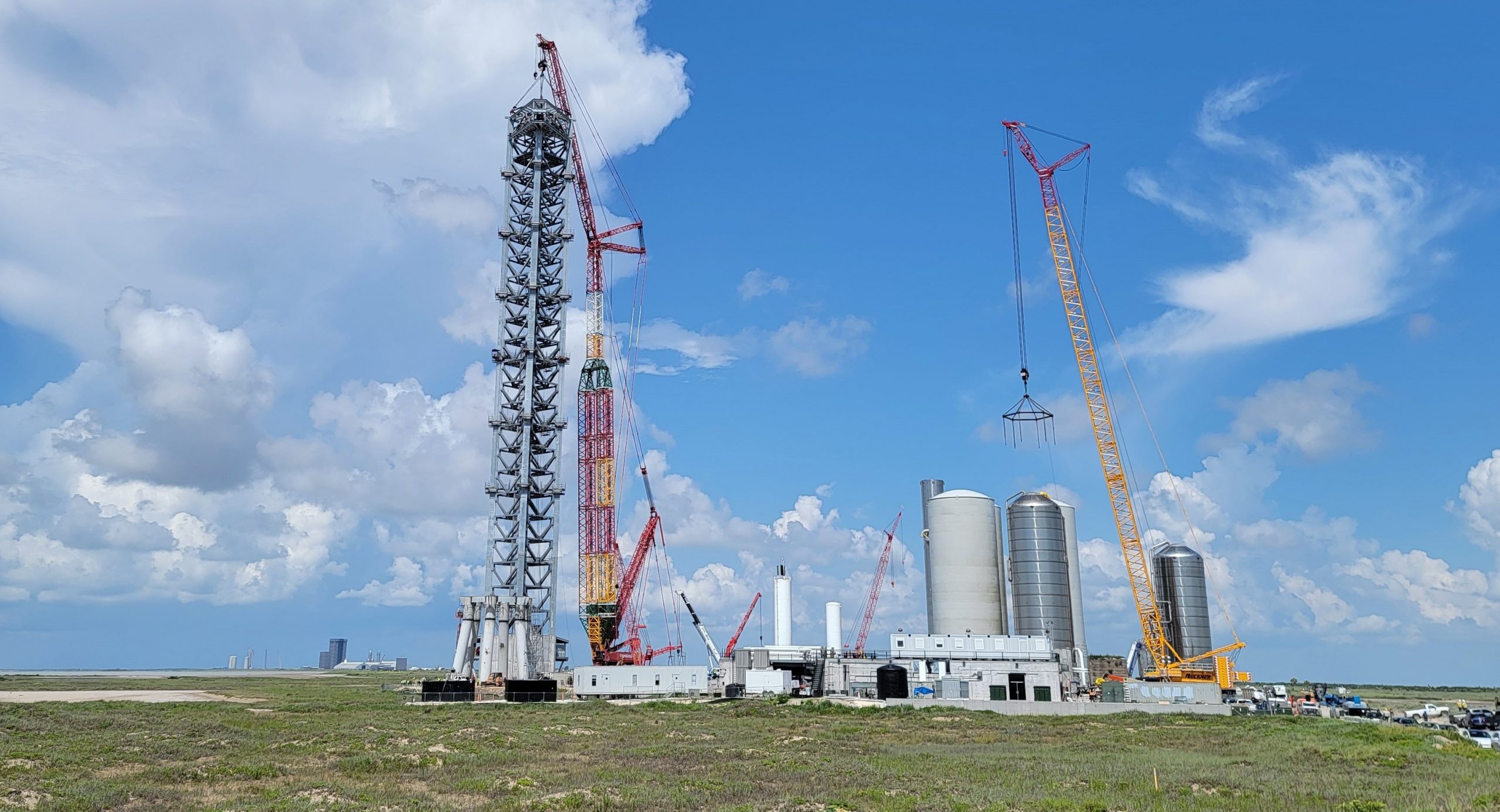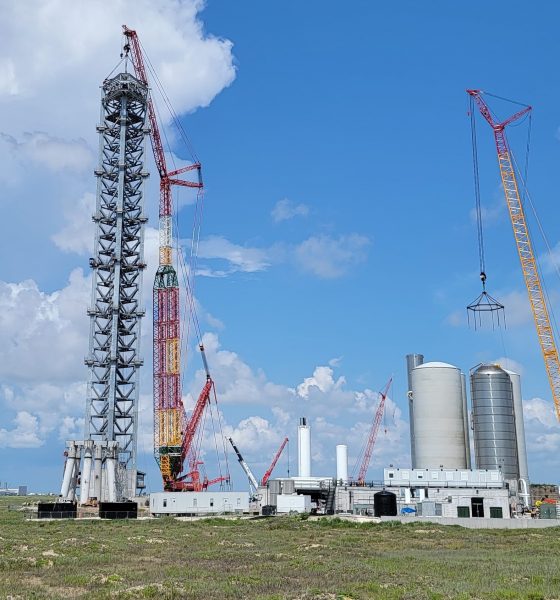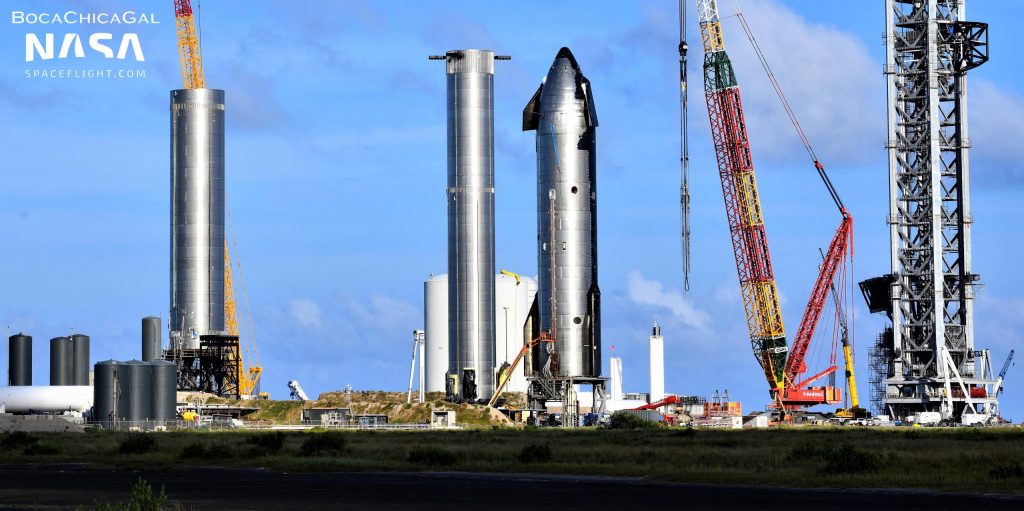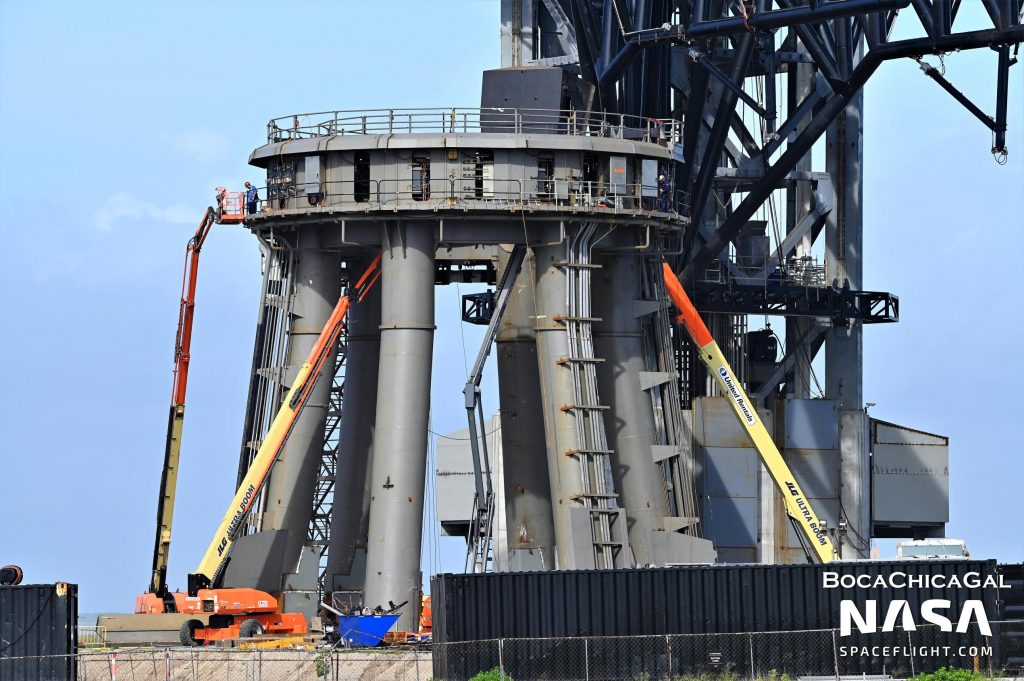

News
SpaceX preparing giant crane to assemble Starship’s first Florida launch tower
SpaceX has begun staging and assembling parts of a giant crane it will soon need to stack Starship’s first East Coast launch tower and install other major launch pad components.
The presence of the base of that crane at SpaceX’s NASA Kennedy Space Center (KSC) Launch Complex 39A was visually confirmed by NASASpaceflight.com photographers during a weekly aerial tour of the area on June 3rd. Four days later, Teslarati photographer Richard Angle observed more major crane components on their way to Pad 39A, including the crane’s cabin.
More likely than not, the crane SpaceX or its contractor has begun assembling at 39A is a Liebherr LR 11350, the same kind of crane the company used to assemble Starship’s first orbital launch site and tower in South Texas. In fact, given how few LR 11350s there are in existence, it’s entirely possible that it’s the exact same crane. Assembly of that crane began around April 2021 and took a month and a half, at which point it was finally ready to lift an extended boom long enough to assemble a tower almost 500 feet (~150 meters) tall.

Pad 39A’s Starship launch tower is expected to be very similar to Starbase’s, although it will undoubtedly carry over numerous design changes thanks to lessons learned while building and outfitting the first tower. In fact, SpaceX has already assembled five of the nine individual sections that will eventually be stacked to form that tower, and one such change is already obvious. Instead of stacking each tower section as soon as its barebones framework is complete, SpaceX is taking a more methodical approach to its second launch tower. In an apparent attempt to limit the amount of work that needs to be done at Pad 39A itself, each of those segments is being thoroughly outfitted with secondary structures (ladders, doors, walkways, frames, raceways, etc.) before stacking.
SpaceX may even pre-install most of the thousands of feet of plumbing needed to connect a Starship to ground systems located around 90 meters (~300 ft) below it. Once stacked, each section – including all those partial propellant and gas lines – will still need to be joined together, but that process should be far easier than fully installing all the systems the tower needs to do its job. Outfitting Starbase’s launch tower, for example, took SpaceX around half a year and, to some extent, is still ongoing 11 months after the final stack. That likely explains why Starship’s 39A tower section assembly appears to be taking more time. With any luck, partially combining the outfitting and section assembly stages will significantly expedite final assembly, as far less work will need to be done at extreme heights or require a skyscraper-sized crane.

Through Starbase, SpaceX has already demonstrated the ability to stack a Starship launch tower from its unoccupied concrete base to its final height of ~145 meters (~475 ft) in about two months flat. While SpaceX will have to slalom its way around Pad 39A’s busy launch manifest, there’s no reason to believe that Starship’s first Florida launch tower won’t be stacked at least as quickly.
Aside from the arrival of crane parts, SpaceX has also made great progress on the Starship launch site itself. In the last few weeks, the company appears to have completed several significant concrete pours on the tower base. SpaceX has also installed all six of the pedestal-like orbital launch mount’s legs after months of foundation work. Elsewhere at Cape Canaveral, a different team has made excellent progress assembling the massive donut-like platform that will sit on top of those legs. Due to its extreme weight (possibly around 300 metric tons, per Elon Musk’s comments on the Starbase mount), the same LR 11350 crane will also be needed for that major installation milestone.

Plenty of parts are still missing, of course. Four tower sections still need to be assembled. Starship’s first Florida launch tower will need its own set of two ‘chopstick’ arms for lifting and (maybe) catching Starship and Super Heavy, as well as a third swinging quick-disconnect arm to connect Starship to ground systems. Aside from delivering several new tanks, SpaceX has also made no apparent progress on adding a massive methane propellant farm to Pad 39A, and it’s possible that the pad’s oxygen farm will also need to be expanded. Propellant storage has proven to be a major headache for SpaceX at Starbase.
Nonetheless, SpaceX is making great progress on most of the most difficult parts of Starship’s first Florida launch site, and there’s a good chance that just like its launch mount, work on the pad’s tower arms is already underway somewhere offsite. A great deal of work remains to be done but SpaceX is still well on its way to launching Starships out of Kennedy Space Center in the not-too-distant future.

News
Nvidia CEO Jensen Huang explains difference between Tesla FSD and Alpamayo
“Tesla’s FSD stack is completely world-class,” the Nvidia CEO said.

NVIDIA CEO Jensen Huang has offered high praise for Tesla’s Full Self-Driving (FSD) system during a Q&A at CES 2026, calling it “world-class” and “state-of-the-art” in design, training, and performance.
More importantly, he also shared some insights about the key differences between FSD and Nvidia’s recently announced Alpamayo system.
Jensen Huang’s praise for Tesla FSD
Nvidia made headlines at CES following its announcement of Alpamayo, which uses artificial intelligence to accelerate the development of autonomous driving solutions. Due to its focus on AI, many started speculating that Alpamayo would be a direct rival to FSD. This was somewhat addressed by Elon Musk, who predicted that “they will find that it’s easy to get to 99% and then super hard to solve the long tail of the distribution.”
During his Q&A, Nvidia CEO Jensen Huang was asked about the difference between FSD and Alpamayo. His response was extensive:
“Tesla’s FSD stack is completely world-class. They’ve been working on it for quite some time. It’s world-class not only in the number of miles it’s accumulated, but in the way it’s designed, the way they do training, data collection, curation, synthetic data generation, and all of their simulation technologies.
“Of course, the latest generation is end-to-end Full Self-Driving—meaning it’s one large model trained end to end. And so… Elon’s AD system is, in every way, 100% state-of-the-art. I’m really quite impressed by the technology. I have it, and I drive it in our house, and it works incredibly well,” the Nvidia CEO said.
Nvidia’s platform approach vs Tesla’s integration
Huang also stated that Nvidia’s Alpamayo system was built around a fundamentally different philosophy from Tesla’s. Rather than developing self-driving cars itself, Nvidia supplies the full autonomous technology stack for other companies to use.
“Nvidia doesn’t build self-driving cars. We build the full stack so others can,” Huang said, explaining that Nvidia provides separate systems for training, simulation, and in-vehicle computing, all supported by shared software.
He added that customers can adopt as much or as little of the platform as they need, noting that Nvidia works across the industry, including with Tesla on training systems and companies like Waymo, XPeng, and Nuro on vehicle computing.
“So our system is really quite pervasive because we’re a technology platform provider. That’s the primary difference. There’s no question in our mind that, of the billion cars on the road today, in another 10 years’ time, hundreds of millions of them will have great autonomous capability. This is likely one of the largest, fastest-growing technology industries over the next decade.”
He also emphasized Nvidia’s open approach, saying the company open-sources its models and helps partners train their own systems. “We’re not a self-driving car company. We’re enabling the autonomous industry,” Huang said.
Elon Musk
Elon Musk confirms xAI’s purchase of five 380 MW natural gas turbines
The deal, which was confirmed by Musk on X, highlights xAI’s effort to aggressively scale its operations.

xAI, Elon Musk’s artificial intelligence startup, has purchased five additional 380 MW natural gas turbines from South Korea’s Doosan Enerbility to power its growing supercomputer clusters.
The deal, which was confirmed by Musk on X, highlights xAI’s effort to aggressively scale its operations.
xAI’s turbine deal details
News of xAI’s new turbines was shared on social media platform X, with user @SemiAnalysis_ stating that the turbines were produced by South Korea’s Doosan Enerbility. As noted in an Asian Business Daily report, Doosan Enerbility announced last October that it signed a contract to supply two 380 MW gas turbines for a major U.S. tech company. Doosan later noted in December that it secured an order for three more 380 MW gas turbines.
As per the X user, the gas turbines would power an additional 600,000+ GB200 NVL72 equivalent size cluster. This should make xAI’s facilities among the largest in the world. In a reply, Elon Musk confirmed that xAI did purchase the turbines. “True,” Musk wrote in a post on X.
xAI’s ambitions
Recent reports have indicated that xAI closed an upsized $20 billion Series E funding round, exceeding the initial $15 billion target to fuel rapid infrastructure scaling and AI product development. The funding, as per the AI startup, “will accelerate our world-leading infrastructure buildout, enable the rapid development and deployment of transformative AI products.”
The company also teased the rollout of its upcoming frontier AI model. “Looking ahead, Grok 5 is currently in training, and we are focused on launching innovative new consumer and enterprise products that harness the power of Grok, Colossus, and 𝕏 to transform how we live, work, and play,” xAI wrote in a post on its website.
Elon Musk
Elon Musk’s xAI closes upsized $20B Series E funding round
xAI announced the investment round in a post on its official website.

xAI has closed an upsized $20 billion Series E funding round, exceeding the initial $15 billion target to fuel rapid infrastructure scaling and AI product development.
xAI announced the investment round in a post on its official website.
A $20 billion Series E round
As noted by the artificial intelligence startup in its post, the Series E funding round attracted a diverse group of investors, including Valor Equity Partners, Stepstone Group, Fidelity Management & Research Company, Qatar Investment Authority, MGX, and Baron Capital Group, among others.
Strategic partners NVIDIA and Cisco Investments also continued support for building the world’s largest GPU clusters.
As xAI stated, “This financing will accelerate our world-leading infrastructure buildout, enable the rapid development and deployment of transformative AI products reaching billions of users, and fuel groundbreaking research advancing xAI’s core mission: Understanding the Universe.”
xAI’s core mission
Th Series E funding builds on xAI’s previous rounds, powering Grok advancements and massive compute expansions like the Memphis supercluster. The upsized demand reflects growing recognition of xAI’s potential in frontier AI.
xAI also highlighted several of its breakthroughs in 2025, from the buildout of Colossus I and II, which ended with over 1 million H100 GPU equivalents, and the rollout of the Grok 4 Series, Grok Voice, and Grok Imagine, among others. The company also confirmed that work is already underway to train the flagship large language model’s next iteration, Grok 5.
“Looking ahead, Grok 5 is currently in training, and we are focused on launching innovative new consumer and enterprise products that harness the power of Grok, Colossus, and 𝕏 to transform how we live, work, and play,” xAI wrote.








